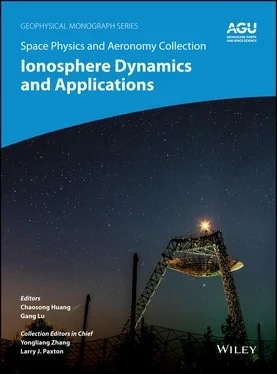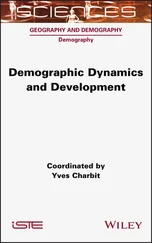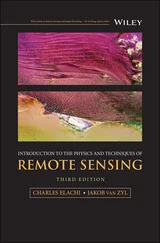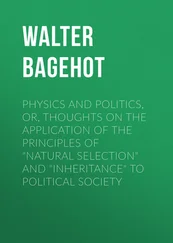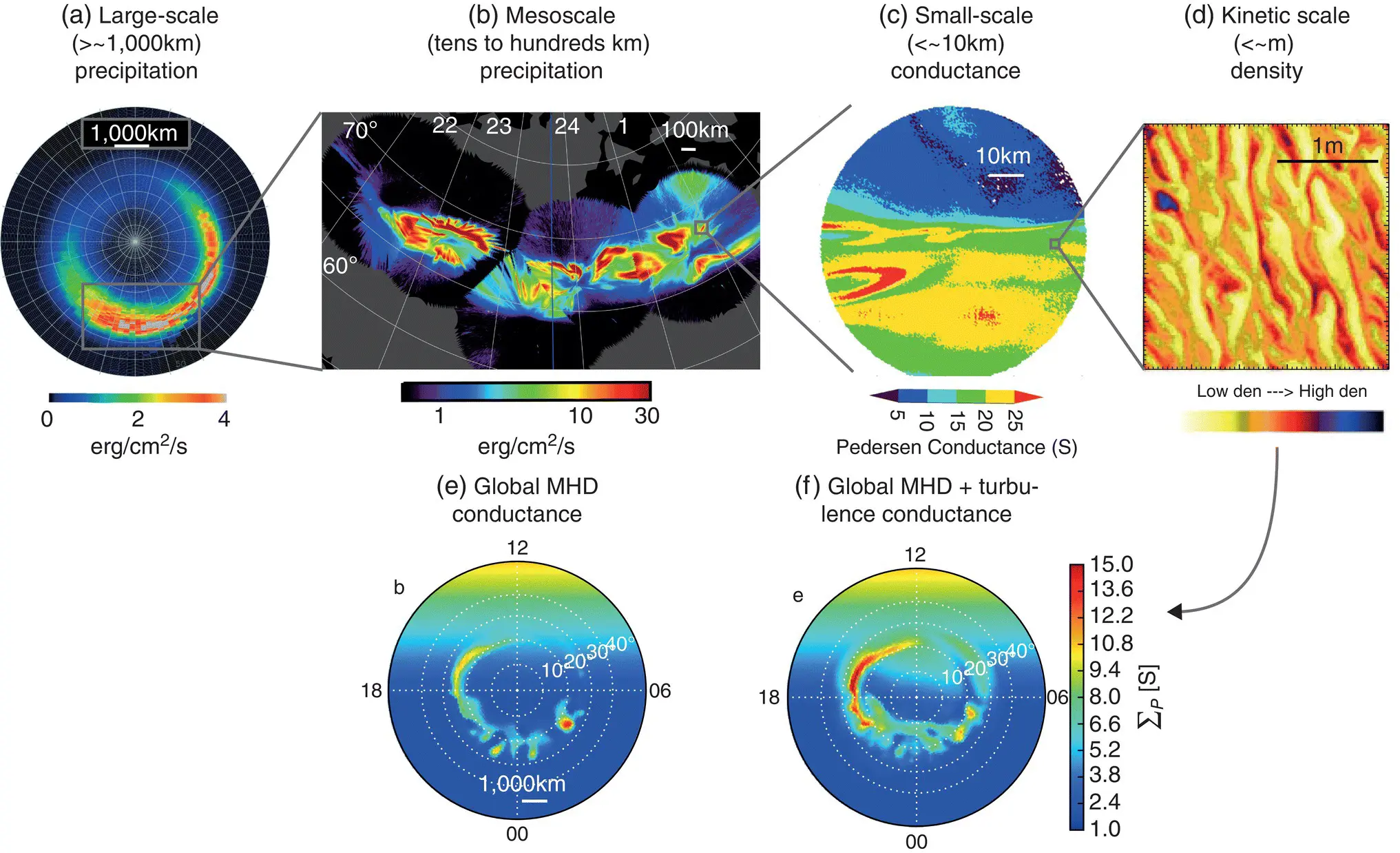
Figure 3.1 Illustration of multiscale processes: (a) Large‐scale statistical precipitating electron energy flux distribution from OVATION‐SM ; (b) instantaneous precipitating electron energy flux distribution in the nightside using THEMIS ASIs (this study); (c) instantaneous small‐scale Pedersen conductance distribution derived from narrow FOV imaging; (d) kinetic simulation of ionosphere density; (e,f) global Pedersen conductance in coupled MHD simulations without and with kinetic turbulence conductance
(a: Mitchell et al., 2013; c: Grubbs et al., 2018; d: Oppenheim & Dimant, 2013; e,f: Wiltberger et al., 2017; Mitchell et al. (2013). Reproduced with permission of John Wiley & Sons).
Also important in the geospace system are coupling processes to adjacent regions. In addition to large‐scale transport processes, mesoscale/small‐scale processes can also propagate over long distances and substantially contribute to processes in surrounding regions. Representative features are schematically illustrated in Figure 3.2and described in later sections. For example, plasma redistribution occurs due to plasma transport from dayside to nightside as polar cap patches and tongues of ionization (TOIs) leading to changes in plasma density structures in surrounding regions. Mesoscale structures such as flow channels play a substantial role in plasma transport, and can also affect energetics in downstream regions.

Figure 3.2 Schematic illustration of various types of high‐latitude mesoscale ionospheric processes. (a) Weak‐moderate and (b) active geomagnetic conditions. The electron auroral oval is marked by the two black circles. The colors indicate the dominant wavelength of optical emission. The colored lines and filled circles indicate arcs and patches of optical emission. The dashed lines and arrows into/out of the plane indicate plasma flows and FACs.
In the following sections, we review properties of mesoscale and small‐scale features and processes in key regions of the high‐latitude ionosphere.
The cusps are regions with enhanced ion (~keV) and electron (tens to hundreds eV) precipitation in the dayside auroral oval near noon in the northern and southern high latitude ionosphere. Number of fluxes of precipitation into the ionosphere are generally the largest in the cusps, which are the regions most directly affected by solar‐wind condition changes. The cusp is typically a single spot extending over a few hours of MLT (~500–1,000 km azimuthally), and its location overall follows the interplanetary magnetic field (IMF) B yand B z(Frey et al., 2003; Newell et al., 2006; Zhang et al., 2013a). However, the cusp is not always a single structure but can bifurcate to two or more, particularly at large IMF | B y| or during IMF orientation changes. Latitudinal bifurcation is considered to reflect low‐ and high‐latitude reconnection at the magnetopause (Sandholt et al., 1998; Pitout et al., 2002), and azimuthal bifurcation has been attributed to component and antiparallel reconnections (Sandholt & Farrugia, 2003; Massetti et al., 2006).
The cusp also exhibits localized and transient structures (Moen et al., 2013). One of the most common types is poleward‐moving auroral forms (PMAFs), which initiate as brightening near the equatorward boundary of the discrete aurora followed by poleward propagation (Sandholt et al., 1998; Sandholt & Farrugia, 2007). PMAFs are associated with soft electron precipitation and dominantly occur under a southward IMF (Drury et al., 2003; Xing et al, 2012). Some of them are triggered by IMF orientation changes (Moen et al., 1999; Milan et al., 2002; Sandholt & Farrugia, 2008; Wang et al., 2016a), while other events do not have any clear interplanetary trigger (Sandholt et al., 2003).
PMAFs are an ionospheric manifestation of bursty reconnection at the dayside magnetopause and subsequent flux transfer events (FTEs) (Lockwood et al., 2001; Neudegg et al., 2001). They are associated with localized flow channels and a wedge‐type FAC loop, where PMAFs correspond to the footprint of the upward FAC (McWilliams et al., 2000; Oksavik et al., 2004). Each localized flow channel has a substantial level of potential drop (~1–10 kV) (Greenwald et al., 1996; Moen et al., 2008) or ~1%–10% of the open flux in the magnetosphere (Fear et al., 2017).
The cusp also involves smaller‐scale variabilities of < ~10 km size, including precipitation (Tanaka et al., 2005; Ebihara et al., 2008), FAC (Neubert & Christiansen, 2003), flow (Keady & Heelis, 1999), and density (Kivanc & Heelis, 1999). Small‐scale density irregularities contribute to radio signal scintillation (Oksavik et al., 2015; Spicher et al., 2016; Jin et al., 2017).
Other types of dayside auroral brightenings are discussed in a separate review article by Nishimura et al. (2018a). These include discrete aurora including throat aurora, and diffuse aurora ( Fig. 3.2). They are sensitive to solar‐wind‐condition changes and magnetosheath transients and can occur even under small IMF B z.
The cusp processes are important to create localized structures that move into and across the polar cap. Enhanced F‐region ionosphere density is often seen in the polar cap, and density enhancements by a factor of 2 from background of > ~100 km size are called polar cap patches (Crowley, 1996). Among many processes proposed (Carlson, 2012), major ideas are (1) FTEs transporting photoionized plasma from dayside closed field lines into the polar cap across the dayside open‐closed field‐line boundary (Lockwood & Carlson, 1992); (2) time‐varying convection forming storm‐enhanced density (SED) and TOIs (Sojka et al., 1994); and (3) ionization by cusp precipitation and transport by flow channels (Rodger et al., 1994). These are competing processes and the dominant mechanism depends on density distributions on closed field lines, flow strength and duration, and precipitation flux. In fact, both elevated and reduced temperatures from surrounding plasma have been identified to be associated with patches (Yin et al., 2008; Zou et al., 2016; Zhang et al., 2017). Elevated and reduced temperatures are considered as indicators of plasma heated by cusp precipitation and of transport of photoionized plasma from closed field lines.
During enhanced geomagnetic activity such as storms, SEDs are often seen to propagate across the cusp and become patches and TOIs (Foster et al., 2005; Carlson et al., 2006), and these high‐density plasma features have lower temperature than in surrounding plasma (Lockwood et al., 2005). Convection of photoionized plasma can also explain the UT and seasonal dependence of patches (Sojka et al., 1994). During nonstorm times, FTEs or cusp ionization becomes more important, as has been seen from patches that move along flow streamlines that are fully in darkness without access of sunlit plasma (Oksavik et al., 2006; MacDougall & Jayachandran, 2007). A density trough can exist between the cusp and photoionized plasma, indicating that photoionized plasma from lower latitudes does not reach the cusp and polar cap during these times. Instead, cusp precipitation creates patches (Rodger et al., 1994; Walker et al., 1999; Smith et al., 2000; Goodwin et al., 2015). Patch formation in association with PMAFs (Lorentzen et al., 2010; Nishimura et al., 2014a; Hosokawa et al., 2016) is another indication that sudden energy input into the cusp contributes to patches.
Читать дальше
